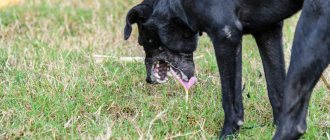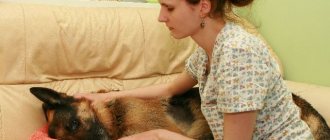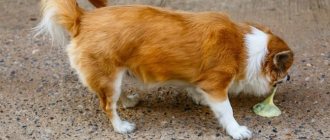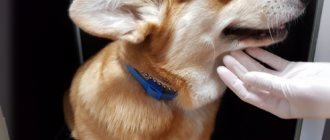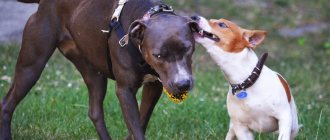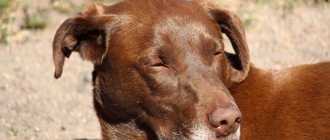Surgical treatment of fractures. Performing the most complex orthopedic operations at the clinic. Postoperative hospital with round-the-clock monitoring of the animal.
Such a nuisance as a broken paw in a dog can befall your pet at absolutely any age and at any time. It is a mistake to believe that such injuries are typical for small breed dogs and puppies, so the owner should always know what help he can provide in such a situation.
Types of fractures
Animals break more than just their paws. The pelvic bones, spine, jaws, skull and even the tail are injured. Every situation is dangerous for the dog. This article addresses the issue of limbs as the most common type of injury.
Dogs' paws consist of tubular bones, so they break easily under strong mechanical stress. To properly help your pet, you need to understand the types of injuries.
Classification
| Type of injury | Peculiarities |
| Crack in the bone | There are no visible signs of damage. The dog remains active at first, only limping slightly. The owner may decide that the animal has a slight dislocation or bruise. Although the bone itself is not damaged and nearby tissues are not damaged, under physical stress the crack may become larger and become a fracture. |
| Impacted fracture | When jumping from a height, a dog may land unsuccessfully on its front paws. As a result, parts of the bones will fit into each other and become fixed. In this case, it is difficult to diagnose a fracture without a special examination. The main symptoms are lameness and pain. If left unattended, serious complications will develop that threaten to immobilize the dog. |
| Open fracture | The injured bone tears the skin and comes out. This not only causes severe pain for the dog, but also increases the risk of infection. The danger lies in the fact that the sharp edges of the bone damage nerves and muscles. Rupture of blood vessels leads to severe blood loss |
| Closed paw fracture | |
| no offset | It is impossible to visually diagnose the injury - the external tissues remain intact. The broken bone is in a natural position, since its ends do not move. The main signs for primary diagnosis are swelling of the tissue at the site of the injury, severe pain during palpation examination. The animal cannot step on the injured limb |
| with offset | The ends of a broken bone spread apart and can damage nearby tissue. In addition to severe swelling, a bulge appears at the fracture site (this is part of the bone). If blood vessels are damaged, a hematoma forms under the skin. The animal experiences unbearable pain. |
Fractures can be minor or complex, but they must be treated in the same way. Even if the dog only has a crack, and it cannot be determined by external signs, any deviation in the pet’s behavior should be a signal to contact a veterinary clinic.
Why is it not recommended to use plaster?
There are a number of reasons for this. First of all, you will not be able to force the dog to take care of its paw in a cast, and even more so you will not be able to provide the animal with constant bed rest or hang the limb in traction. Animals always try to immediately get rid of the cast, chew it off or remove it from furniture, or simply limp awkwardly, which brings additional pain and injury.
In addition, since dogs do not often develop cracks or ordinary fractures without displacement, a simple cast is not suitable for them, and they have to set the fragments and compare the fragments. Also, thanks to numerous studies, it was possible to establish that the most complete fusion occurs only with rigid fixation, good blood circulation and early support on the limb. If you use plaster casts, it is unlikely that all these factors will be met. That is why not only in veterinary, but also in human orthopedic practice, operations are often used that allow recovery to occur faster and with better quality.
Features of postoperative rehabilitation
As a rule, the dog spends up to 24 hours after surgery under the supervision of a doctor. Next, suture treatment and pain relief are prescribed for several days. It is best if you limit your pet's mobility for 4-5 weeks to maximize the successful rehabilitation of the paw. In most cases, weight bearing gradually returns 3-4 days after surgery.
After a few weeks, it is necessary to take a control x-ray to help evaluate the fusion. Depending on the type of injury, complete recovery occurs over a period of several months to six months; for example, if a dog has a fractured jaw, it will be much more difficult to treat.
Currently reading:
- Thyroid dysfunction in dogs (hypothyroidism)
- What to do if your dog chokes on a bone
- Actions to take in case of an epileptic attack and a shaking dog
- The American Cocker Spaniel is an adroit hunter and loyal friend.
Symptoms of injury
If the hind or front paw is damaged, the symptoms are identical:
the animal does not stand on the broken limb, but holds it suspended in a bent position;- does not allow you to touch the sore paw, whines at the slightest touch to it;
- a broken paw swells very quickly, increasing in size;
- a complete fracture leads to deformation of the limb;
- if a displacement occurs, the paw will move on its own, dangling as the animal moves.
Even one symptom is enough to suspect injury, especially if the pet appears lethargic and sick. The dog must immediately be carefully laid down and protected from physical activity until examined by a doctor.
Symptoms of a broken paw in a dog
Fractures may be obvious, especially if the broken bone protrudes beyond the skin. Any sign of pain or discomfort after a fall or other injury may indicate a fracture or dislocation. You may also think that your dog has a broken bone if you notice the following symptoms:
● Whining or howling
● Lameness
● Swelling and hematoma on the limb
● Deformity with shortening of the paw
● Abnormal limb movement
● The dog does not rest on its paw, but keeps it suspended
● Pain
● Reluctance or inability to walk
Abscesses, growths, migrating grass seeds, and injuries to muscles, tendons, and ligaments can cause similar symptoms and the same level of pain. Therefore, it is so important to carry out timely diagnosis.
Methods for diagnosing the extent of damage
Only a veterinarian after examination can tell how complex the injury is. First, the doctor gives the dog an anesthetic injection to relieve unpleasant symptoms.
The examination includes:
- radiography in several projections;
- for diagnosing internal injuries MRI or ultrasound;
- urine and blood tests;
- in case of an open fracture, a smear from the wound.
Having received all the necessary data, the doctor prescribes treatment. It can be conservative or surgical (depending on the severity of the problem).
How to provide first aid to a pet?
Having detected signs of injury, the owner must provide first aid to the animal. Securely fix the fracture and the damaged limb itself so that the pet cannot cause itself further harm from fear or pain. It is also important to calm the animal and limit the possibility of movement as much as possible.
Sequence of actions for open damage:
- Stop the bleeding.
- Clean the wound from dirt and foreign bodies.
- Treat with an antiseptic.
In case of arterial bleeding, it is necessary to apply a tourniquet using available means: leash, collar, scarf.
To avoid infection, a bandage is applied to the damaged area and the dog is provided with maximum rest until the doctor arrives or arrives at the veterinary clinic.
If the dog is large and cannot be carried in your arms, you can help it get up and start moving by passing a towel, leash, or blanket under the chest, thereby supporting the animal.
First aid for an animal
The sooner an injured animal is taken to the clinic, the greater the chance of avoiding complications. But first of all, the owner himself provides emergency care to the pet.
To begin with, the dog is put on a muzzle so that the animal does not accidentally bite the owner in pain.
Help with an open fracture
At home, a pressure bandage is applied to the dog's paw, placing a tourniquet over the bleeding area.
The wound is treated with hydrogen peroxide or any other antiseptic and covered with sterile gauze folded in several layers. If this is not possible, use a clean cloth and the dog is immediately taken to the clinic.
If the fracture is closed
In this case, a splint is applied to the paw in the area of injury (wooden sticks, a flat board, or, in extreme cases, a piece cut from a plastic bottle). This is secured with a bandage or piece of fabric.
The fixation should not be too tight so as not to complicate the situation.
If the fracture is displaced, under no circumstances should they reset the bone into place on their own . This leads to irreversible consequences.
Caring for your pet during recovery at home
After the doctor provides assistance, caring for the animal falls on the shoulders of the owner. The duration of the rehabilitation period directly depends on the correct implementation of all instructions. At home, the owner should closely monitor the condition of the animal, and in case of any deviations in behavior or health, consult a doctor.
Movement restrictions
The rehabilitation period should take place while restricting the animal's movement. The dog needs rest. The owner should not allow the pet to make sudden movements. If there is a possibility of your dog jumping, then you should use a crate.
It should be spacious and match the height of the animal. Walking an animal should be carried out with all types of injuries, except for spinal injuries. To help your pet, you can support the body with a scarf or towel.
Important! The dog will not touch the stitches if you put on a protective collar. During walking, it is necessary to ensure that the injured area does not swell.
Diet
The animal's diet during the rehabilitation period should be different from usual. Since the animal moves little, it needs fewer calories. Increasing your pet's weight will place additional stress on the injured area. Therefore, during this period it is better to use dry food for nutrition. It is low in calories and contains useful vitamins and minerals necessary for recovery. Be sure to give your pet drinking water in unlimited quantities.
How long does it take for dog fractures to heal?
What are the consequences of untimely treatment, poorly secured bone fragments, or failure to follow doctor’s recommendations? The consequences can be different: from the occurrence of infection and prolongation of the rehabilitation period to improper healing or even non-healing of the injury. To avoid this, it is necessary to take care of the animal not only during the period of illness, but also after it. In order for the callus to become sufficiently strong, sudden movements of the pet should be limited for another six months after recovery.
Cracks in dogs heal up to 20 days, fractures 1.5–2 months. The recovery period for bone damage depends not only on the degree of injury, but also on the age of the animal, breed, timely and correct treatment. For young puppies it lasts 3–5 weeks, for older puppies it is delayed as a result of changes in metabolism and lasts up to 8 weeks. Small breeds take longer to recover. Their fracture zone, with a thin layer of muscle, has poor blood circulation. As a result of surgical treatment, the animal recovers within 5–7 weeks.
When is surgery performed?
For mild cracks, conservative treatment is used. The dog's paw is fixed with external splints and medications are prescribed depending on the degree of damage and the condition of the pet.
When surgery is necessary:
- in case of injury to the tibia or calcaneus;
- with closed and open fractures;
- when driving bone into bone.
During preparation for surgery, the doctor not only numbs the injury, but also puts the dog to sleep with anesthesia. After using muscle relaxants, the surgeon begins to move the bones into place.
If the fracture is open or the bones are broken into pieces, the operation will take longer. In order for further fusion to be of high quality, it is important to correctly arrange the fragments and fix them well.
During surgery, doctors use various devices to secure the limb in a stationary position:
- plates and pins;
- wire and knitting needles;
- screws, screws, staples.
Previously, metal clamps were used, which caused discomfort to the animal. Nowadays, more comfortable polymer products are increasingly being used.
If the paw was broken not by a puppy, but by a dog, then in case of complex injuries, special structures are applied to restore the bone. They are selected taking into account the breed.
Devices for osteosynthesis
| Name | Peculiarities |
| Ilizarov | The design is a combination of metal rings and spokes. Used to fix limbs in large dogs |
| Kirchner | The device is assembled from metal or plastic rods and self-tapping screws in the form of rods (needles). More suitable for small animals |
For dogs of large breeds, the Kishner design is put on, if it is not possible to use the Ilizarov apparatus (for example, in case of severe intra-articular fractures).
A little anatomy or which parts of the paws are at risk
Dogs use 4 paws to move. The forelimbs consist of:
- shoulder and humerus;
- the forearm, in which the ulna and radius bones are united by a joint;
- wrists of 7 bones, connected to the heel bones;
- calcaneus (carpal) with 5 fingers.
The hind limbs have a slightly different structure and consist of:
- thigh with the femur, which is connected by a joint to the pelvic bone;
- knee;
- lower leg with tibia and fibula;
- hock joint;
- foot along with metatarsus and toes.
It is the hind limbs that are much stronger and stronger than the forelimbs. With their help, a push is performed for a jerk or jump.
Rehabilitation period: how to care for a dog
The recovery period usually lasts from a month to 40 days, but in an old dog it can take 2 times longer. Afterwards, the fixation is removed from the paw, and the pet gradually returns to its usual rhythm of life.
During the rehabilitation period, the following rules are adhered to:
for better bone healing, the dog is limited in its movements (if possible, use a crate);- while the pet is deprived of physical activity, only low-calorie food is introduced into the diet so that the animal does not gain extra pounds;
- meals should be balanced, scheduled according to the hour;
- if the animal cannot yet move independently, then a bowl of food and drinking containers are brought to the place where the dog is lying;
- to restore damaged tissue and quickly heal the fracture, the dog is given mineral and vitamin supplements and calcium-containing preparations;
- if there was an open wound and surgery was performed, the pet is prescribed a course of antibiotics (injections or oral);
- You should not walk the dog earlier than 3-4 weeks after the injury, but you can take it (or take it in a stroller) out into the fresh air, limiting the duration of the walk to 30 minutes;
- In a private house in the summer, the animal can be placed on an open veranda; in an apartment, an alternative would be a balcony (loggia), this will replace the dog’s regular walks.
If you had to resort to surgical intervention and dressings are required, then it is advisable to do this at home so as not to further strain the sick dog.
How long does it take to heal
Healing of bone injuries in dogs goes through several stages. After 10 - 15 days
A connective tissue callus is formed. The fusion of bone fragments occurs by 35–45 days.
Dogs begin to include the damaged limb in the support function at the moment when the formation of a bone callus occurs. Until this moment, sick animals protect their broken paw.
In order to prevent infection after osteosynthesis, a sick animal must be prescribed a course of antibacterial drugs. On the recommendation of a veterinary surgeon, the animal can be prescribed immunomodulators, vitamins, and minerals.
4-5 weeks after osteosynthesis, the animal is given a control radiography to assess the effectiveness of the operation.
Measures to prevent fractures
A pet can get injured even at home by carelessly jumping off the sofa. But most often fractures occur while walking.
To avoid having to provide first aid to your pet, it is better to avoid such situations altogether, adhering to the basic rules.
When walking your dog, you need to make sure that it does not fall under the wheels of vehicles (even a bicycle is dangerous).- You should choose the right places for walking so that while frolicking, your pet does not injure its paw on a foreign object or step into a pothole if it lands unsuccessfully.
- During training, exercises are selected taking into account the animal's capabilities.
- You should not leave your pet unattended so that it does not get into a fight with other dogs or fall from a height.
- When moving on the subway, be careful to ensure that the paws do not get stuck in the moving mechanism and are not pinched by the closing car door.
A hunting dog can get caught in a trap. The service dog runs the risk of being shot by a bullet that shatters the bone.
Particular attention should be paid to a pet who already has an old fracture.
Even a severe injury to this area can lead to serious consequences. In addition to mechanical effects, the causes of injuries can be pathologies caused by inflammatory processes in bone tissue, osteoporosis .
This happens against the background of improper metabolism, and it is a consequence of poor nutrition, so the animal’s diet should always be enriched with minerals and vitamins.
How can the doctor help?
The veterinarian will numb the animal and examine it. This is very important if the dog was hit by a car or fell from a height, because in addition to the fracture that is obvious to you, the pet may have other internal injuries. During the examination, the doctor takes an X-ray of the bone, assesses the characteristics of the fracture and plans treatment. By the way, treating your dog’s paw injuries is not the cheapest service, the cost of which depends on the complexity and characteristics of the animal’s rehabilitation. However, self-medication of even minor cracks is highly discouraged, otherwise they can develop into more serious injuries.
It will be informative about the cause of spasms in dogs
According to statistics, most paw fractures in animals require surgical intervention called osteosynthesis. Due to physiological characteristics, this operation is performed several days after the injury. By the way, this rule does not apply to open fractures, in which, in order to avoid infection, the operation must be performed as urgently as possible. Special attention is paid to a hip fracture in a dog, which requires a completely different approach to treatment.
Diagnosis and treatment
Before treating a dog for a sprained paw or a sprained ligament, the veterinarian will conduct an examination and, if necessary, order an x-ray. In some cases, an MRI may be necessary. For mild to moderate sprains, treatment can be done at home:
- on the second day - apply warm compresses;
- on the third - perform a light massage, continue warming wraps and apply paraffin applications;
- on the fourth and further, they begin to rub in external preparations with troxevasin.
Any dislocations are treated exclusively by a veterinarian. In this case, the easiest way to treat is an uncomplicated dislocation of a dog’s front paw: the damaged joint is reduced and then fixed with a bandage or splints. If necessary, an open reduction method can be used, in which tumors that appear as a result of damage are surgically removed from the articular cavity. In any case, even the simplest treatment of medial luxation of the patella in a dog is carried out under general anesthesia.
In case of hip dislocation, from which no more than 5 days have passed, the joint is also reduced and fixed. If such a procedure does not give the desired results or the dislocation lasts more than 5 days, surgical intervention is required to install special clamps or remove the femoral head.
Treatment for a shoulder dislocation in a dog depends on the degree of instability and damage to the joint. Minor injuries require medication and physical therapy. In case of severe injury, a capsule or artificial ligament is usually sewn in.
In the absence of proper treatment, which should begin immediately after the injury, scar tissue forms in the joint area, which does not allow the joint to be straightened and requires more serious and expensive treatment. Any incorrect actions can lead to lifelong lameness of the dog with chronic pain syndrome.
What should a dog's diet be like during an injury?
The correct diet during the period of forced reduction in the animal’s activity should have lower caloric content than in the period before the injury.
If the owner takes this circumstance into account and continues to feed the full diet during a fracture, the animal may gain excess weight, which will increase the load on the limbs and negatively affect rehabilitation, and can subsequently lead to obesity.
One option for a responsible approach to feeding a sick dog would be to purchase special ready-made food designed for such cases. In this case, it is important to follow the manufacturer's instructions located on the packaging of the finished food.
Basic rules of diet during the recovery period:
- Reducing daily caloric intake.
- Introduction to the menu of foods or feeds enriched with vitamin D, calcium, copper, manganese and magnesium.
It is better to discuss special nutrition with a veterinarian, who can take into account both the sufficient supply of vital substances and nutritional value.
Video: limb fractures in dogs, their symptoms and treatment
